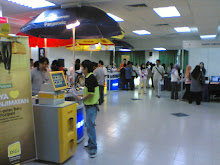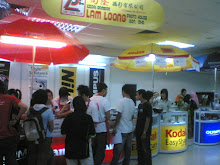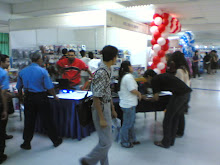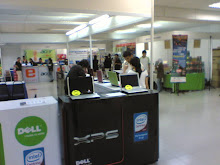Saya dan beberapa kawan saya telah dipanggil untuk memasang komputer jenis Dell



CENTRE for KNOWLEDGE, COMMUNICATION and TECHNOLOGY(PPKT)
Centre for Knowledge, Communication and Technology (PPKT –Malay acronym) was officially formed in late 2002. Encompassing 4 ICT base departments which are the Computer Centre, Information Technology Centre, SISMAP and IT Development Unit of Registry, PPKT serves the University needs on ICT matters and its key function is to plan and implement ICT projects. Its value added service is to consult / advise the University with regard to utilizing, managing and linking Knowledge / Information, Communications and Technology.
As the main ICT service centre, PPKT adopts the university IT Strategic Plan (ISP) since 2007. 4 areas of focus are:
1. Network Infrastructure
2. System Applications and databases integration
3. Disaster Recovery and server consolidation
4. ICT Governance and CRM
PPKT plays an important role in improvements to daily operational processes for administration and acts as a catalyst towards information and knowledge lead research campus.
OBJECTIVE
1. Strategy as everyone’s business
2. Improve Business Processes
3. Improve on Information Availability
4. Improve on Communications between campus communities
5. Improve the Environment through Green IT Initiatives
VISION
excellence as a recognized ICT
provider locally and globally in-line
with the University’s mission."
Providing sustainable, reliable, up-to-date, conducive and friendly ICT services supporting:
• Teaching and Learning
• Research and Development
• Administration and Management

PROFILE
Universiti Sains
HISTORY
In 1969, the
In April 1969, Professor Hamzah Sendut was elected the Vice-Chancellor. Two months later, a group of 57 students was accepted to begin their studies. Since the area of Sungai Ara could not be developed as fast as required, the group was placed at the Malayan Teachers’
Since its beginning, USM has implemented a school system, as opposed to the traditional faculty system. What is unique about this system is that each school could fulfill the needs of a more focused degree in the chosen area of study and at the same time, students could have the opportunity to explore other areas of study offered by another school.
The interdisciplinary approach ensures that USM, the first in the country to adopt this system, would produce trained, multi-skilled graduates.
THE EMBLEM of USM
The Emblem is divided into four parts representing the Malaysian environment. The emblem consists of a few symbols that reflect its identity as a Malaysian university of international standard.
The crescent and the star with its fourteen points which decorate the top of the emblem symbolize the membership and the unity of the thirteen states of the federation with the federal government. It also represents the greatness and the identity of the Islamic religion, the official religion in
The open book above the shield signifies knowledge, appropriate to the role of an academic institution.
USM brand in the shape of type logo is specially design has been launch by Seri Paduka Baginda Raja Permaisuri Agong who is
GOVERNANCE
D.Y.M.M. Tuanku Syed Sirajuddin Ibni Al-Marhum Tuanku Syed Putra Jamalullail
Pro Chancellor
Y. Bhg. Tan Sri Dato’ Dr. Lin See-Yan
Y. Bhg. Tan Sri Razali Ismail
Chairman of the Board
Y. Bhg. Tan Sri Dato’ Haji Ani bin Arope
Vice-Chancellor
Y. Bhg. Profesor Dato’ Dzulkifli Abdul Razak
Deputy Vice-Chancellor
Y.Brs. Profesor Madya Omar Osman (Hal Ehwal & Pembangunan Pelajar)
Y.Brs. Profesor Ahmad Shukri Mustapa Kamal (Hal Ehwal Akademik & Antarabangsa)
Y.Brs. Profesor Asma Ismail (Penyelidikan & Inovasi)
Y.Brs. Profesor Lim Koon Ong (Jaringan Industri dan Masyarakat)
Executive Power
The University is administered by the executives under the Board of Directors whose members are chosen from the University, representatives from the government and the elected members from the Education Ministry. As an executive body, the Board of Directors is authorized to act according to the University Constitutions, Statutes, Acts and Rules and Regulations as stipulated
THE
Cara-cara untuk mendapatkan wireless didalam windows vista
1-) Klik pada Menu start.
· Taip CMD ( command prompt) pada search dan tekan enter.
· Ataupun boleh memilih menu command prompt pada list menu.

· Taipkan ipconfig/all dan enter.

3-) Satu tertingkap terhasil yang mengandungi maklumat-maklumat
mengenai komputer tersebut.Seperti yang ditunjukkan didalam rajah
2-) Satu paparan command prompt akan terhasil.
Apabila paparan terhasil taipkan Getmac/v dan tekan enter.

3-) Selain daripada menggunakan ipconfig/all,kita juga dapat menggunakan
Getmac/v command prompt bagi windows jenis vista.

.jpg)
.jpg)
.jpg)
.jpg)